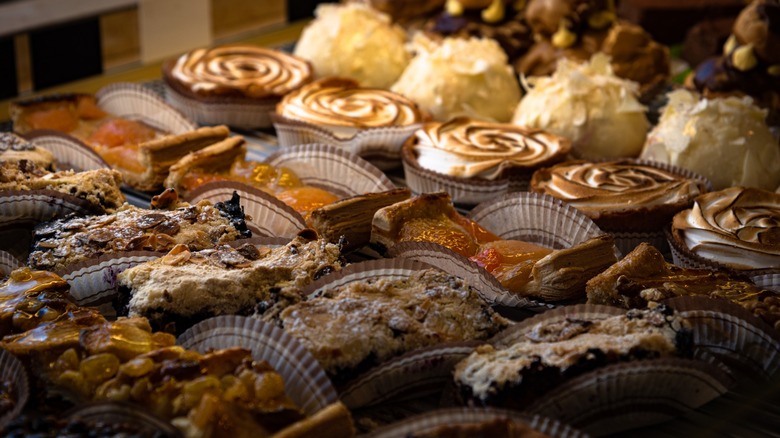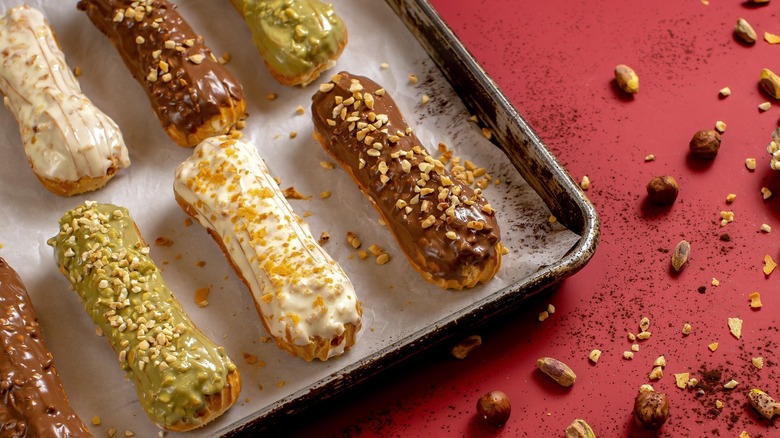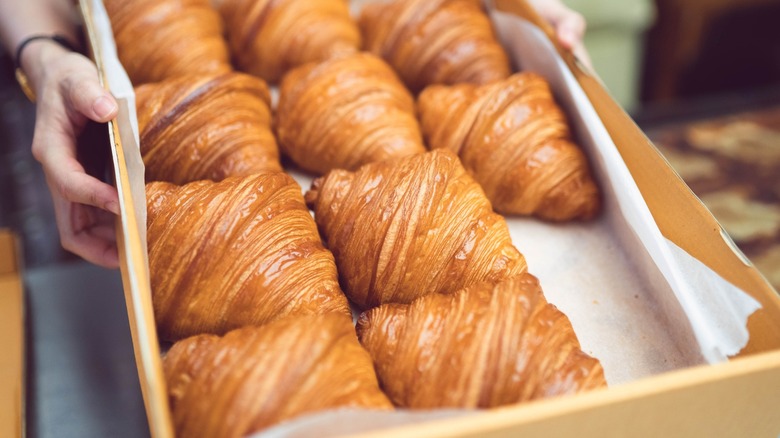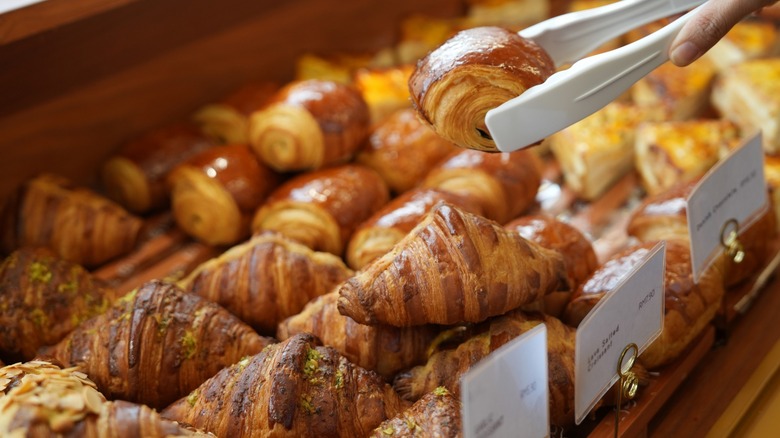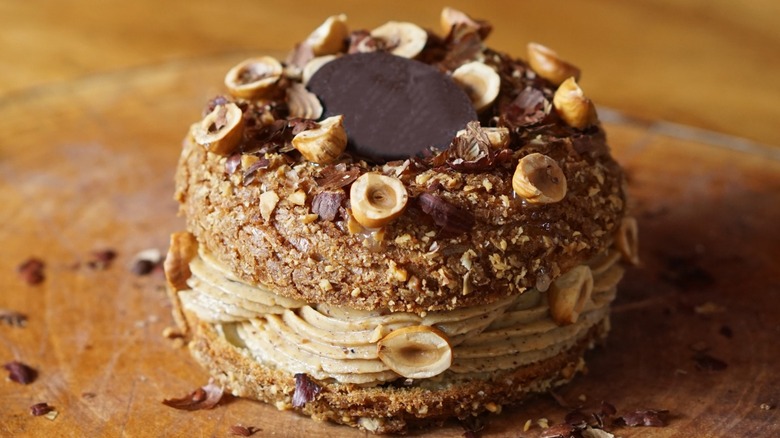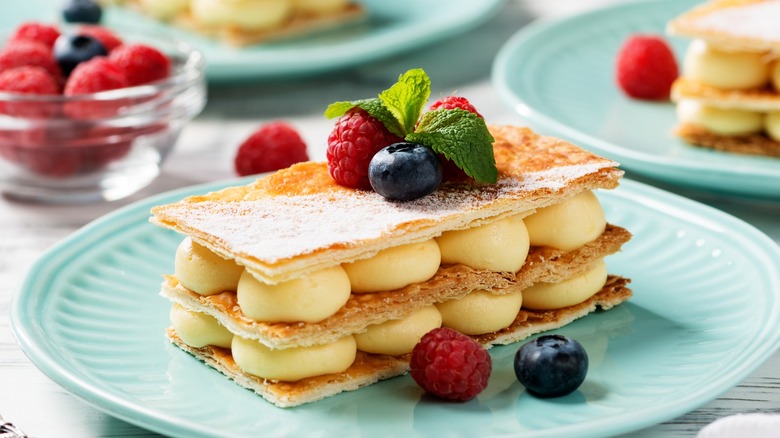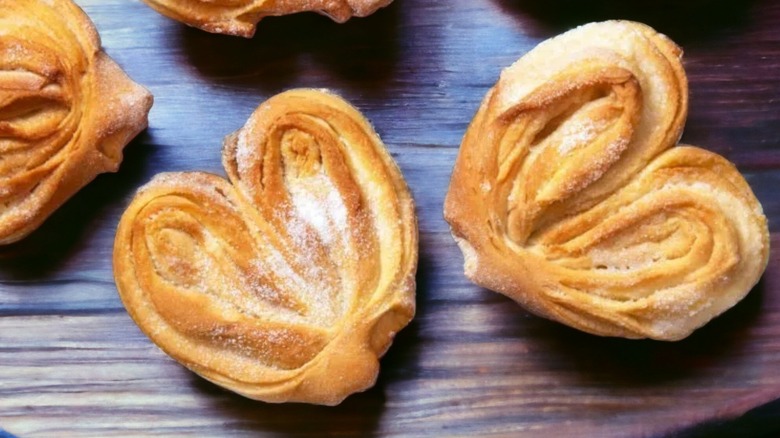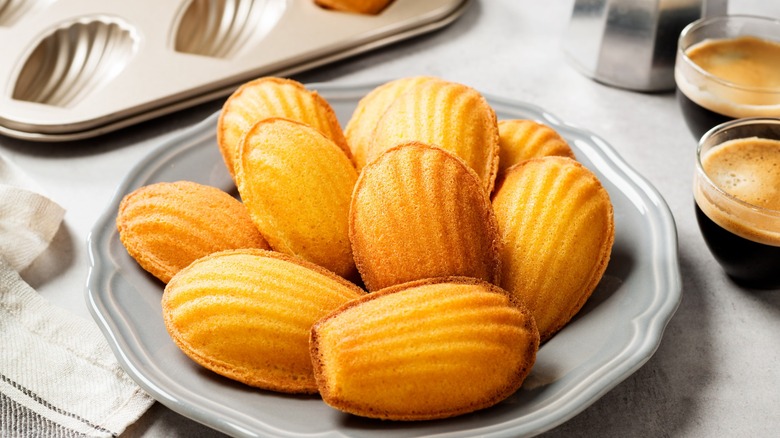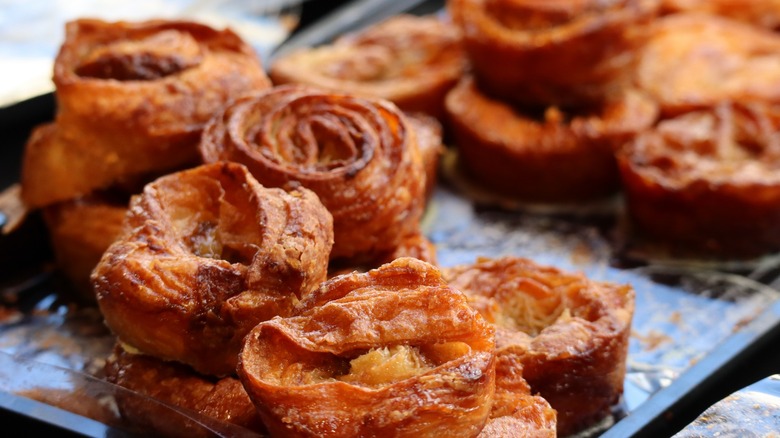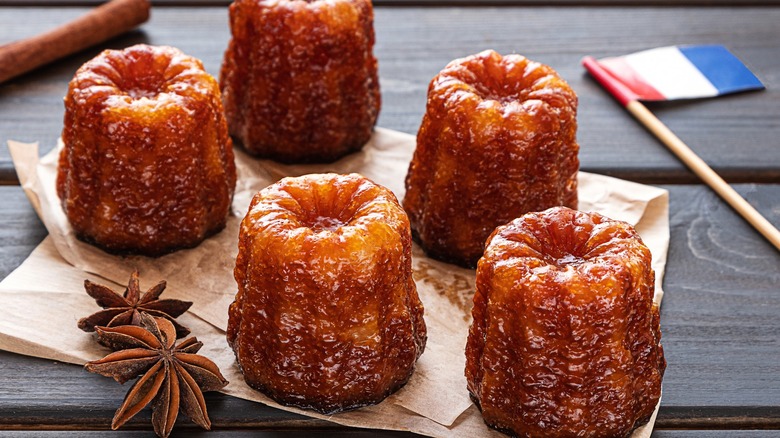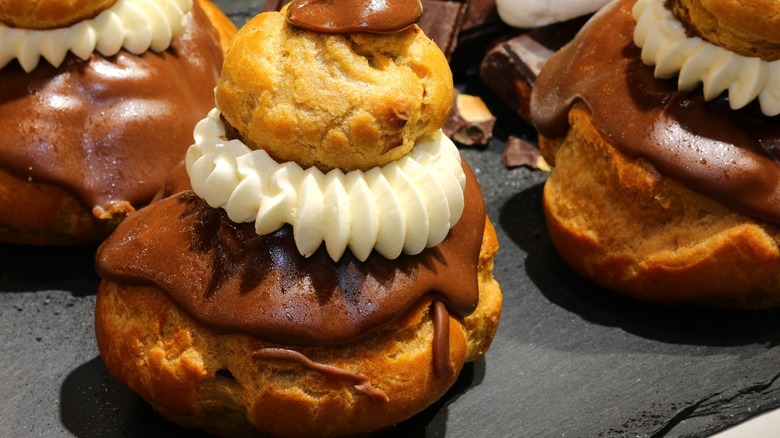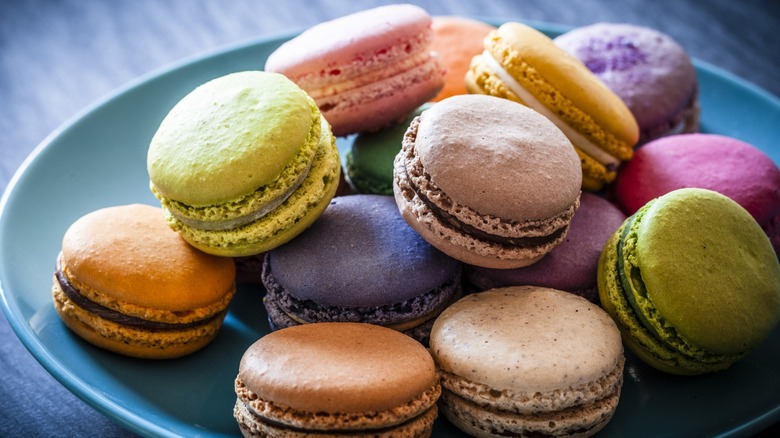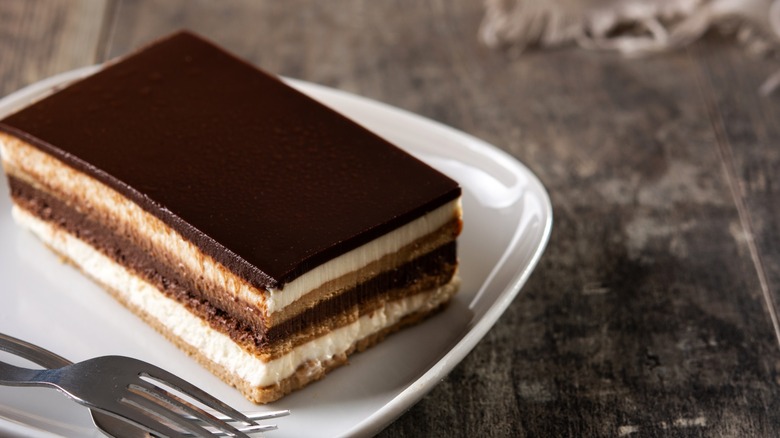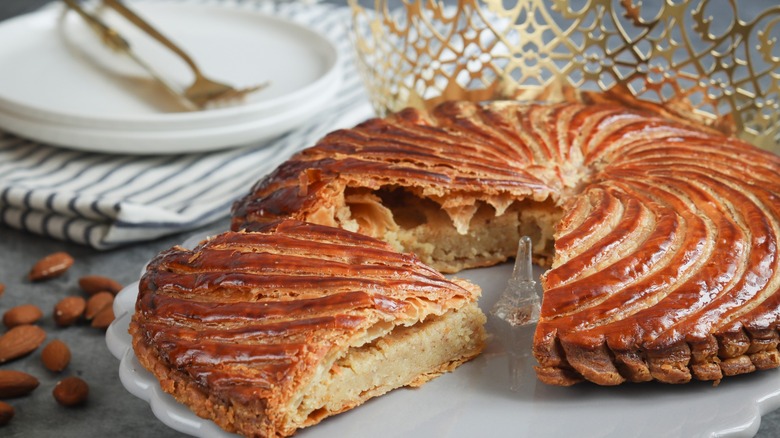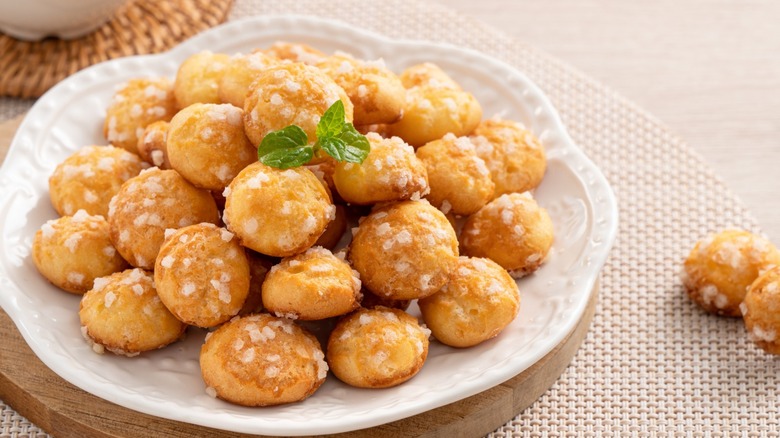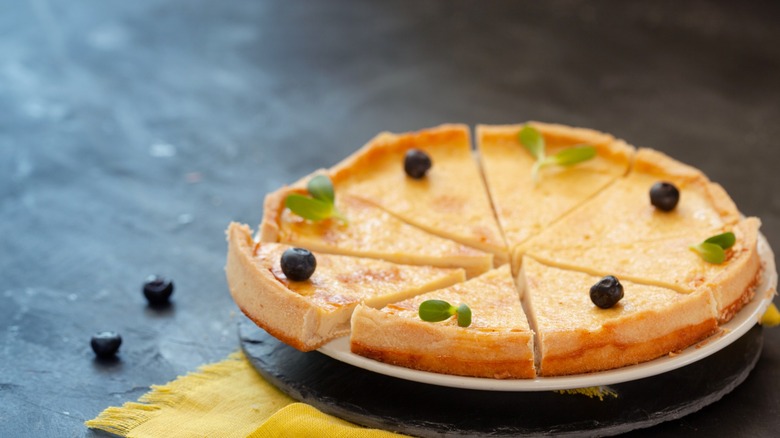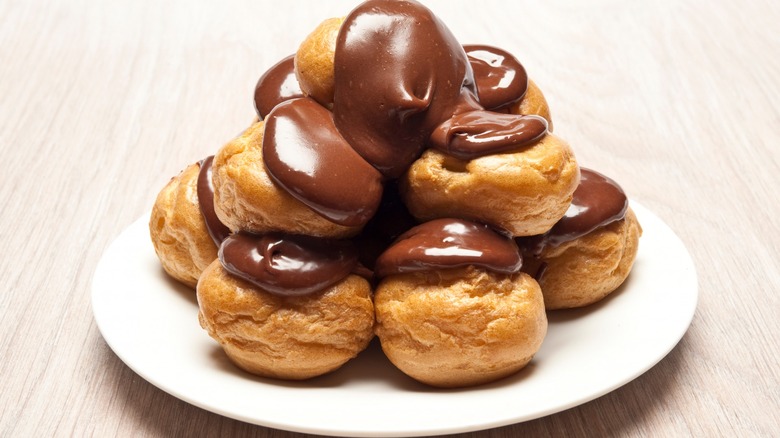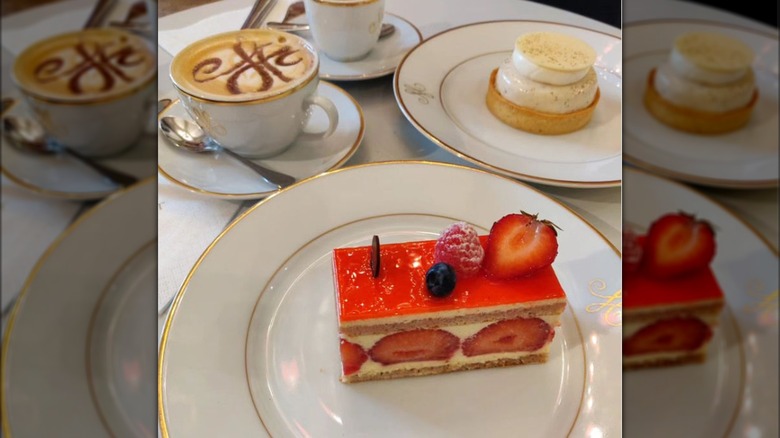The 18 Best French Pastries You Need To Try At Least Once
Is there anything more delicious than a French pastry? Whether savory or sweet, France is home to some of the best pastries around. There are some we're all familiar with, like croissants, eclairs, and pain au chocolat; then there are others, like Paris-Brest and Kouign Amann that are generally only found in France — or in a good French bakery or patisserie in your city, if you're lucky.
French pastries run the gamut from simple yet delicious to intricate and indulgent — and though they're usually sweet, they can also be savory. So if you're new to exploring the world of French pastries, where do you start?
We can't possibly cover every single pastry out there, so this isn't a definitive list, and it's in no particular order. However, we've rounded up the 18 best French pastries to try on your next trip to France, or visit to your neighborhood patisserie. Which will you try first?
1. Éclair
Most of us are familiar with the chocolate éclair, the choux pastry delight filled with whipped cream and topped with a chocolate fondant icing. But there's much more to this humble pastry. In France — or in a good patisserie — you'll find many different flavors with colorful icing and toppings.
The éclair originated in the 19th century and its name means "flash of lightning." The name could refer to the way it reflects light from its shiny fondant topping, but it could also come from how quickly the pastry is devoured — in a flash.
The inventor of the éclair is said to be Marie-Antoine Carême, a pastry chef working in a patisserie located near Paris' Palais Royale in the 18th century. The pastry later rose to fame when Christophe Adam's L'Eclair de Genie shop in Paris started selling more than 60 different varieties
In France, a traditional éclair isn't filled with cream like those we know and love in the U.S. French éclairs are usually filled with crème pâtissière, which is often fruit flavored. Other fillings include custard or chestnut puree.
2. Croissant
When you think of France, buttery, flaky croissants spring to mind. These pastries are a type of Viennoiserie, which we'll get into later, but they deserve their own spot on our list.
It may surprise you to know that croissants didn't actually originate in France. The pastry's origins actually date back to Austria in the 13th century.
In Austria, croissants were known as kipferl, meaning "crescent" in German. The original kipferl was more like a cookie than the pastry we know today and came to Paris when August Zang, an artillery officer from Austria, opened a bakery in Paris serving up kipferl and other specialties from Vienna.
The French decided to name their version of the pastry after the kipferl, calling it "croissant," which means crescent in French. The French version was made with puff pastry, giving us the breakfast treat we know and love today.
3. Tarte Tatin
Tarte Tatin originated in France in the 1880s and takes its name from its creators, the Tatin sisters. To make a traditional Tarte Tatin, the apples are caramelized with sugar and vanilla — and sometimes cinnamon — pastry is added on top, and after cooking, the tart is turned out onto a plate.
The history of the Tarte Tatin is a happy accident. The story goes that sisters Caroline and Stéphanie Tatin ran a hotel in France, where Stéphanie was the cook. One lunch service, while preparing dessert, she was baking a tart in the oven but had forgotten to add pastry to the already-caramelizing apples. Panicking, she popped some pastry on top of the apples, and the Tarte Tatin was born!
4. Viennoiseries
You may already be familiar with the term Viennoiseries. If you're not quite sure what it means, the word relates to any pastries eaten for breakfast, such as croissants, pain au chocolat, or pain aux raisins.
These pastries are so-called because they're baked in a style that started in Vienna in the 1840s. Earlier, we spoke about August Zang, the Austrian military official who opened his Boulangerie Viennoise in Paris. It was Zang's bakery that sparked the popularity of Viennoiseries, securing them as the breakfast of choice for French people around the country.
Today, you'll find a wide range of Viennoiseries to choose from, depending on the boulangerie or patisserie you visit. Everything from croissants to brioche and chausson aux pommes (apple turnover) can be found, but breakfast pastries often sell out fast, especially on weekends.
5. Paris-Brest
Paris-Brest are extremely popular delicacies in France, but you won't often find them in the U.S. unless you visit a specialist French patisserie. These sweet treats are made from choux pastry with a filling of praline-flavored cream and flaked almonds.
The Paris-Brest is so-called as it was created for the Paris to Brest roundtrip cycle race in 1910 by pastry chef Louis Durand. Some say the pastry is round in homage to a bicycle wheel.
There are several variations on the Paris-Brest, but the classic recipe includes whipped crème mousseline, to which a hazelnut and almond praline paste is added. This mixture is piped onto a ring of choux pastry and topped with another ring of pastry. Powdered sugar and flaked almonds are often used to garnish the finished cake.
6. Mille-feuille
Mille-feuille means "a thousand sheets." Don't be fooled by the name, though — this pastry is usually made with three puff pastry layers sandwiched with two layers of crème patissier and topped with powdered sugar or fondant. It's often served with jam or fruit as a garnish. In the U.K., it's sometimes known as a custard slice.
The origins of Mille-feuille are unclear. It's first mentioned in a French cookbook in the 17th century. However, it's often also called "Napoleon," not in reference to the French military commander, but to the Italian city of Naples. Some attribute the creation of this dessert to Dijon chef François Pierre de la Varenne. Whether Mille-feuille originated in Italy or France, we don't know. However, it's generally accepted that one of the most famous French chefs, Marie-Antoine Carême, later polished the recipe to make the Mille-feuille we know and love today.
7. Palmiers
Palmiers are one of the most popular French pastries. The name means "palm tree," as each puff pastry treat is shaped to look like a palm leaf. Though palmiers are traditionally sweet, you'll also find savory varieties.
Palmiers taste sort of like a light, buttery puff pastry cookie. Some recipes add cinnamon, walnuts, cocoa powder, or citrus peel.
Though we don't know much about the origins of these little pastries, there is an interesting legend associated with the beginnings of puff pastry in France. The story goes that it was invented by Claudius Gelée, a pastry cook, in the 17th century. One day, while planning to make a butter cake with water, butter, and flour, Gelée forgot to add the butter to the dough. As he'd already rolled it out, he simply added the butter to the rolled-out pastry, before folding and rolling it out several more times. When he removed the resulting pastry from the oven, it was incredibly puffy and light. The resulting pastry became known as "puff paist" — or so the legend tells us.
8. Madeleines
Madeleines are one of the most common French pastries outside France, and you'll find them in many bakeries and grocery stores across the U.S. and Europe. These little light, soft sponge cakes are made with butter, sugar, eggs, and flour, and are usually cooked in a special pan that gives them their signature grooved shape.
One origin story dates Madeleines to the 18th century, crediting their invention to a chef named Madeleine Paulmier. The story goes that Paulmier made the little cakes for Stanislas Leszczyński, Poland's deposed king, while he was exiled in the Lorraine region. Legend says his wife loved the tiny cakes so much that she began to serve them at Versailles, from where their popularity spread across France.
Whatever the origin of Madeleines, they're inextricably linked with the French town of Commercy. It's said that bakers here paid a tidy sum for the recipe so they could sell boxes of the cakes to residents and visitors.
9. Kouign Amann
Unlike some of the other sweet pastries on our list, this next pastry has a salty-sweet flavor that makes it incredibly delicious. Kouign-Amann is a Breton pastry made with layers of puff pastry. Its name is pronounced as "Queen-a-mahn," and it's unlikely you'll find it outside France unless you're lucky enough to have a specialist French patisserie in your city.
Kouign-Amann comes from the French town of Douarnenez, a place renowned for its butter. It makes sense then that the pastry's name means "butter cake."
As with so many other French pastries, it seems that this one's origins were also a happy accident. Kouign-Amann was supposedly created in the 19th century by patissier Yves-Rene Scordia. When there were no more desserts to sell, Scordia is said to have baked some bread dough layers sprinkled with sugar and salt, resulting in the sweet yet savory cake.
10. Canelé
This beautifully presented rum and vanilla-flavored pastry features a caramelized crust with a creamy custard center, ensuring its place as one of the most decadent French treats. Canelé take their name from the French word for "fluted," hence the pastry's shape.
Originating in Bordeaux, these cakes were once called Canellé Bordelaise. Their history is somewhat murky, though they're generally assumed to date back to somewhere between the 15th and 18th centuries and could have been invented in convents in the region. At the time, wine was clarified using egg whites, so nuns would often be given the remaining yolks for baking.
11. Religieuse
The Religieuse, meaning "nun" is one of France's most famous pastries. Two choux pastry buns sit on top of each other, a larger one on the bottom, with a smaller one on top, topped with chocolate ganache. The pastry is supposed to look like a nun wearing a habit.
You'll most commonly find the Religieuse filled with custard, chestnut cream, or flavored crème pâtissière. Coffee and caramel are popular flavors, but rose isn't uncommon either.
This French pastry was actually created by an Italian! It's thought to be the invention of pastry chef Frascati, who designed the cake in Paris in the 19th century. There are earlier mentions of a similar Religieuse, though, dating back as far as the 16th century.
12. Macaron
It's hard not to be wowed by the pastel-perfect array of macarons you'll see in patisserie windows. But did you know that these French sweet treats have their roots in Italian monasteries?
Macarons have been enjoyed in France since the early 1500s when it's said that Catherine de Medici brought them to the country. The version we know today originated in France around the 1830s. The traditional macaron features two pieces of round almond meringue sandwiched with flavored buttercream or ganache. It's light, airy, and delicate.
Later, the Macaron Sisters, nuns Sister Marie-Elisabeth and Sister Marguerite, made the treats popular when they sold "Nancy Macarons" or shells made from meringue, without any filling. The filled version we enjoy these days was popularized by the French pastry chef Ladurée.
Today, the Ladurée patisseries in Paris are amongst the most popular in the city. You can even order a macaron wedding cake from them!
13. Opéra
Who could resist thin layers of almond-flavored sponge soaked in coffee, layered with chocolate ganache and coffee buttercream, and topped with chocolate icing? That's the Opera cake, so named as its many layers are said to resemble an opera theater's levels.
The creator of the Opera is said to be pastry chef Cyriaque Gavillon, with the cake becoming popular during its time for sale at French pastry shop Dalloyau in 1955. It's thought the pastry's name may have been inspired by a comment by Gavillon's wife, who said it reminded her of the Palais Garnier opera house in Paris.
The Opera cake usually consists of three layers. It's so popular that you'll find it in almost every good boulangerie or patisserie in France.
14. Galette des Rois
The Galette des Rois, which literally means "King's cake," is the pastry most commonly served on Epiphany in France, which falls on January 6. This flaky puff pastry tart is filled with rich, almond frangipane and usually has a small figurine, trinket, or bean known as a "fève" hidden inside. According to tradition, the person who finds this becomes Queen or King for a day and can order others to do their bidding.
Supposedly, this cake was created to honor the three kings who traveled to see the baby Jesus — though many people say that isn't true and that the dessert was created in more modern times. Either way, depending on where you purchase your Galette des Rois, it will likely be decorated with a small crown.
15. Chouquettes
Loosely translated as "little bits of choux," chouquettes are bite-size sweet French pastries. Each pastry is made from choux dough filled with mousse or custard and sprinkled with pearl sugar.
In France, chouquettes are often enjoyed as an afternoon snack. But these tiny pastries once went by a less flattering name.
The story goes that in Italy in the mid-16th century, Catherine de Medici's pastry chef was experimenting with desserts one afternoon when he perfected small puffs of dough fried in oil. Initially known as "pets de nonnes," which translates as "nun's puffs" or "nun's farts," the tiny pastries would go on to become les chouquettes.
Whatever their origins, chouquettes are a delicious snack or sweet treat. You'll find them in most patisseries and bakeries across France, and in larger French bakeries in the U.S.
16. Flan Pâtissier
Flan Pâtissier may sound fancy, but it's actually just a custard tart, a bit like pastel de nata from Portugal. You'll find this in most patisseries in France, though it may also be called Parisian Flan.
A classic Flan Pâtissier is simply a pastry base filled with vanilla-infused custard cream. Despite its popularity in France, the word flan actually has Roman roots. It comes from the old French word "flaon" which itself originates from the Latin "fladon."
History aside, Flan Pâtissier is a simple dessert but a popular one. If you can't find it in your local patisserie, you can make it yourself with a few high-quality ingredients.
17. Profiteroles
Most of us have tried the classic French dessert of profiteroles. These little balls of choux pastry are filled with whipped cream, custard, or ice-cream and topped with a chocolate or caramel sauce — or powdered sugar.
Profiteroles are often served in a tower formation, which makes them popular for weddings and other celebrations. Did you know that the profiterole actually has Italian roots? Choux pastry was the creation of Catherine de Medici's head chef Pantanelli, back in the mid-16th century.
It was French chef Antoine Carême who came up with the idea of filling the choux buns with cream, though. This became common practice in the 18th century, when Carême also created the "croquembouche" or profiterole tower that's such a popular wedding cake in France today.
18. Fraisier
Fraisier, which literally means "strawberry cake," is not to be confused with Framboisier, which is made with raspberries. This fruity French cake is made with layers of Genoise sponge soaked in strawberry syrup, Mousseline or Diplomat cream (or buttercream), and fresh strawberries. Some more inventive recipes also contain marzipan.
We don't know who created the Fraisier, but it's thought to date back to around 1860, around the same time that the Opera cake became popular. Some credit the Fraisier's creation to Gaston Lenôtre, a French pastry chef. Lenôtre's original creation in 1966 was named "Bagatelle" after the Bois de Boulogne's Bagatelle Gardens.
